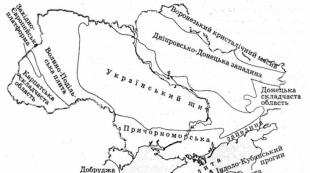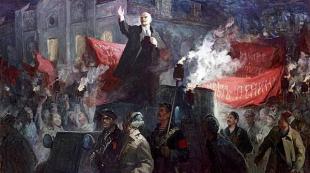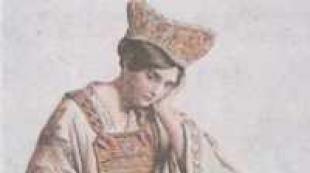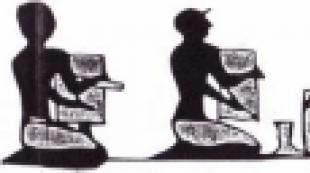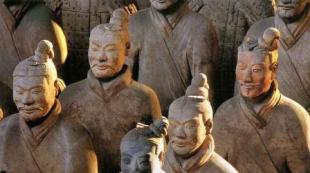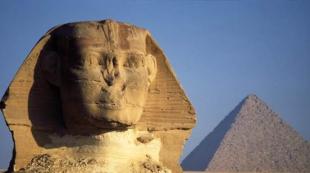Where did the revolution of 1917 begin? When was the revolution in Russia? July Government crisis, failed offensive and execution of Mata Hari
By the evening of February 27, almost the entire composition of the Petrograd garrison - about 160 thousand people - went over to the side of the rebels. The commander of the Petrograd Military District, General Khabalov, is forced to inform Nicholas II: “I ask you to report to His Imperial Majesty that I could not fulfill the order to restore order in the capital. Most of the units, one after the other, have betrayed their duty, refusing to fight against the rebels. "
The idea of a "cartel expedition", which provided for the removal of hotel military units from the front and sending them to rebellious Petrograd, did not have a continuation either. All this threatened to result in a civil war with unpredictable consequences.
Acting in the spirit of revolutionary traditions, the rebels freed from prison not only political prisoners, but also criminals. At first they easily overcame the resistance of the "Kresty" guards, and then took the Peter and Paul Fortress.
The unruly and motley revolutionary masses, not disdaining murder and robbery, plunged the city into chaos.
On February 27, at about 2 pm, the soldiers occupied the Tauride Palace. The State Duma found itself in an ambiguous position: on the one hand, according to the emperor's decree, it should have dissolved itself, but on the other hand, the pressure of the rebels and the actual anarchy forced to take some action. A compromise solution was a meeting disguised as a "private meeting".
As a result, it was decided to form a government body - the Provisional Committee.
Later, the former Minister of Foreign Affairs of the Provisional Government P. N. Milyukov recalled:
"The intervention of the State Duma gave the street and military movement a center, gave it a banner and a slogan and thus turned the uprising into a revolution that ended with the overthrow of the old regime and dynasty."
The revolutionary movement grew more and more. The soldiers seize the Arsenal, the Central Post Office, the telegraph office, bridges and train stations. Petrograd was completely at the mercy of the rebels. A real tragedy broke out in Kronstadt, which was swept by a wave of lynching, which resulted in the murder of more than a hundred officers of the Baltic Fleet.
On March 1, the chief of staff of the Supreme Commander-in-Chief, General Alekseev, in a letter pleads with the emperor "for the sake of saving Russia and the dynasty, to put at the head of the government a person whom Russia would trust."
Nicholas declares that by giving rights to others, he deprives himself of the power bestowed on them by God. The possibility of a peaceful transformation of the country into a constitutional monarchy had already been missed.
After the abdication of Nicholas II, which took place on March 2, a dual power actually took shape in the state. Official power was in the hands of the Provisional Government, but real power belonged to the Petrograd Soviet, which controlled the troops, railways, post office and telegraph office.
Colonel Mordvinov, who was on the tsar's train at the time of his abdication, recalled Nikolai's plans to move to Livadia. “Your Majesty, go abroad as soon as possible. Under the current conditions, even in the Crimea, there is no life, ”Mordvinov tried to convince the tsar. "No way. I would not want to leave Russia, I love her too much, ”objected Nikolai.
Leon Trotsky noted that the February uprising was spontaneous:
“No one outlined in advance the ways of a coup, no one from above called for an uprising. The indignation that had accumulated over the years burst out to a large extent unexpectedly for the masses themselves. "
However, Miliukov insists in his memoirs that the coup was planned shortly after the start of the war and before "the army was supposed to go on the offensive, the results of which would have radically stopped all hints of discontent and would have caused an explosion of patriotism and jubilation in the country." “History will curse the leaders of the so-called proletarians, but it will also curse us, who caused the storm,” the former minister wrote.
British historian Richard Pipes calls the actions of the tsarist government during the February uprising "fatal weak will", noting that "the Bolsheviks in such circumstances did not hesitate to shoot."
Although the February Revolution is called "bloodless", it nevertheless claimed the lives of thousands of soldiers and civilians. In Petrograd alone, more than 300 people died and 1200 were injured.
The February revolution began the irreversible process of the collapse of the empire and the decentralization of power, accompanied by the activity of separatist movements.
Poland and Finland demanded independence, they started talking about independence in Siberia, and the Central Rada formed in Kiev proclaimed an "autonomous Ukraine".
The events of February 1917 allowed the Bolsheviks to come out of the underground. Thanks to the amnesty announced by the Provisional Government, dozens of revolutionaries who were already hatching plans for a new coup d'etat returned from exile and political exile.
The event that happened October 25, 1917 in the capital of the then Russian Empire, Petrograd, was simply an uprising of an armed people, which stirred up almost the entire civilized world.
A hundred years have passed, but the results and achievements, the impact on the world history of the October events remain the subject of discussions and disputes among numerous historians, philosophers, political scientists, specialists in various fields of law, both in our time and in the past twentieth century.
In contact with
Briefly about the date October 25, 1917
Officially in the Soviet Union today this controversial event was called - the day of the October Revolution of 1917, it was a holiday for the entire vast country and the peoples inhabiting it. She brought a radical change in the socio-political situation, transformation of political and social attitudes on the position of peoples and each individual individually.
Today, many young people do not even know in what year the revolution took place in Russia, but it is necessary to know about it. The situation was quite predictable and was brewing for several years, then significant major events of the October Revolution of 1917 took place, the table is brief:
What is the October Revolution in terms of history? The main armed uprising, led by V. I. Ulyanov - Lenin, L. D. Trotsky, J. M. Sverdlov and other leaders of the communist movement in Russia.
Revolution of 1917 - an armed uprising.
Attention! The uprising was carried out by the Military Revolutionary Committee of the Petrograd Soviet, where, oddly enough, the majority was represented by the Left SR faction.
The following factors ensured the successful implementation of the coup:
- Significant level of support from the popular masses.
- The provisional government was inactive and did not solve the problems of Russia's participation in the First World War.
- Most significant political aspect compared to previously proposed extremist movements.
The Menshevik and Right Socialist Revolutionary factions were unable to organize a more or less realistic version of an alternative movement in relation to the Bolsheviks.
A little about the reasons for the October events of 1917
Today, no one refutes the idea that this fateful event practically turned not only the whole world, but also radically changed the course of history for many decades to come. Far from being a feudal bourgeois country striving for progress, it was practically overturned directly during certain events on the fronts of the First World War.
The historical significance of the October Revolution, which took place in 1917, is largely determined by the cessation. However, as modern historians see it, there were several reasons:
- The influence of the peasant revolution as a social and political phenomenon as an exacerbation of the confrontation between the peasant masses and the landowners who remained at that time. The reason - the well-known in history "black redistribution", that is distribution of land to the number of needy... Also in this aspect, the negative impact of the procedure for the redistribution of land allotments on the number of dependents affected.
- The working class experienced significant city pressure on the inhabitants of rural areas, state power has become the main lever of pressure on the productive forces.
- The deepest decomposition of the army and other power structures, where the majority of the peasants went to the service, who could not comprehend these or those nuances of the protracted hostilities.
- Revolutionary fermentation of all strata of the working class... The proletariat at that time was a politically active minority, accounting for no more than 3.5% of the active population. The working class was largely concentrated in industrial cities.
- The national movements of the popular formations of imperial Russia developed and reached their culmination. Then they strove to achieve autonomy, a promising option for them was not just autonomy, but a promising one. independence and independence from the central authorities.
To the greatest extent, it was the national movement that became the provoking factor in the beginning of the revolutionary movement on the territory of the vast Russian Empire, which literally disintegrated into its component parts.
Attention! The combination of all causes and conditions, as well as the interests of all segments of the population, determined the goals of the October Revolution of 1917, which became the driving force behind the future uprising as a turning point in history.

Popular unrest before the start of the October 1917 revolution.
Ambiguous about the events of October 17
The first stage, which became the basis and the beginning of the worldwide change in historical events, which became a turning point not only on a domestic but also on a global scale. For example, an assessment of the October Revolution, interesting facts of which are in the simultaneous positive and negative impact on the socio-political world situation.
As usual, every significant event has objective and subjective reasons. The overwhelming majority of the population had a hard time going through wartime conditions, hunger and deprivation, the conclusion of peace became necessary. What conditions developed in the second half of 1917:
- Formed in the period from February 27 to March 03, 1917, the Provisional Government headed by Kerensky didn't have enough tools to solve all problems and questions without exception. The transfer of land and enterprises to the ownership of workers and peasants, as well as the elimination of hunger and the conclusion of peace became an urgent problem, the solution of which was not available to the so-called "temporary workers".
- The prevalence of socialist ideas among broad strata of the population, a noticeable increase in the popularity of Marxist theory, the implementation by the Soviets of the slogans of universal equality, the prospects for what the people expected.
- The appearance in the country of the strong opposition movement led by a charismatic leader, which was Ulyanov - Lenin. At the beginning of the last century, this party line became the most promising movement for achieving world communism as a concept for further development.
- In the conditions of this situation, they have become the most in demand radical ideas and requiring a radical solution of the problem of society - the inability to lead the empire from the thoroughly rotten tsarist administrative apparatus.
The slogan of the October revolution - "peace to the peoples, land to the peasants, factories to the workers" was supported by the population, which made it possible to radically change the political system in Russia.
Briefly about the course of events on October 25
 Why did the October Revolution happen in November? The autumn of 1917 brought an even greater increase in social tension, political and socio-economic destruction was rapidly approaching its peak.
Why did the October Revolution happen in November? The autumn of 1917 brought an even greater increase in social tension, political and socio-economic destruction was rapidly approaching its peak.
In the field of industry, financial sector, transport and communication systems, agriculture a complete collapse was brewing.
Russian multinational empire fell apart into separate nation states, contradictions between representatives of different peoples and intra-tribal disagreements grew.
A significant impact on the acceleration of the overthrow of the Provisional Government had hyperinflation, rising food prices against the backdrop of lower wages, an increase in unemployment, a disastrous situation on the battlefields, the war dragged on artificially. A. Kerensky government did not submit an anti-crisis plan, and the initial February promises were practically abandoned altogether.
These processes in the conditions of their rapid growth only increased influence leftist political movements across the country. These were the reasons for the unprecedented victory of the Bolsheviks in the October Revolution. The Bolshevik idea and its support by peasants, workers and soldiers led to the receipt parliamentary majority in the new state system - the Soviets in the First Capital and Petrograd. The plans for the coming to power of the Bolsheviks were in two directions:
- Peaceful diplomatically conditioned and legally confirmed transfer of power to the majority.
- The extremist trend in the Soviets demanded armed strategic measures, in their opinion, the plan could only be implemented forceful grip.
The government, created in October 1917, was called the Soviets of Workers 'and Soldiers' Deputies. The shot of the legendary cruiser "Aurora" on the night of October 25 gave signal to start the assault Winter Palace, which led to the fall of the Provisional Government.
October Revolution
October coup
Consequences of the October Revolution
The consequences of the October Revolution are mixed. This is the coming to power of the Bolsheviks, the adoption by the II Congress of Soviets of Workers 'and Soldiers' Deputies of the Decree on Peace, Land, the Declaration of the Rights of the Peoples of the Country. Was created Russian Soviet Republic, later the controversial Peace of Brest was signed. In various countries of the world, pro-Bolshevik governments began to come to power.
The negative aspect of the event is also important - it has begun protracted that brought even greater destruction, crisis, famine, millions of victims... The collapse and chaos in a huge country led to the economic destruction of the world financial system, a crisis that lasted for more than a decade and a half. Its consequences have weighed heavily on the shoulders of the poorest. This situation became the basis for a decrease in demographic indicators, a lack of productive forces in the future, human casualties, and unplanned migration.
According to modern history, there were three revolutions in tsarist Russia.
Revolution of 1905
Date: January 1905 - June 1907 The impetus for the revolutionary actions of the people was the shooting of a peaceful demonstration (January 22, 1905), in which the workers, their wives and children took part, led by a priest, whom many historians later called a provocateur, who specially led the crowd under rifles.
The result of the first Russian revolution was the Manifesto adopted on October 17, 1905, which provided Russian citizens with civil liberties based on personal inviolability. But this manifesto did not solve the main issue - hunger and industrial crisis in the country, so the tension continued to build up and was later defused by the second revolution. But the first answer to the question: "When was the revolution in Russia?" will be - 1905.
February bourgeois-democratic revolution of 1917
Date: February 1917 Hunger, political crisis, protracted war, dissatisfaction with the tsar's policies, ferment of revolutionary sentiments in the large Petrograd garrison - these factors and many others led to a complication of the situation in the country. The general strike of workers on February 27, 1917 in Petrograd escalated into spontaneous riots. As a result, the main government buildings and the main structures of the city were captured. Most of the troops went over to the side of the strikers. The tsarist government was unable to cope with the revolutionary situation. The troops called from the front could not get into the city. The result of the second revolution was the overthrow of the monarchy, and the establishment of a Provisional Government, which included representatives of the bourgeoisie and large landowners. But along with this, the Petrograd Soviet was formed as another authority. This led to a dual power, which badly affected the establishment of order by the Provisional Government in a country exhausted by a protracted war.
October Revolution of 1917
Date: October 25-26, old style. The protracted First World War continues, Russian troops are retreating and being defeated. Hunger continues in the country. The bulk of the people live in poverty. Numerous rallies are taking place in factories, factories and in front of military units stationed in Petrograd. Most of the military, workers and the entire crew of the cruiser "Aurora" took the side of the Bolsheviks. The Military Revolutionary Committee announces an armed uprising. October 25, 1917 there was a Bolshevik coup led by Vladimir Lenin - the Provisional Government was overthrown. The first Soviet government was formed, later in 1918 a peace was signed with Germany, already tired of the war (the Brest Peace), and the construction of the USSR began.
Thus, we get that the question "When was the revolution in Russia?" you can shortly answer this: only three times - once in 1905 and twice in 1917.
On February 23, 1917, the February Revolution of 1917 began, otherwise called the February bourgeois-democratic revolution, or the February coup - massive anti-government demonstrations by the workers of the city of Petrograd and soldiers of the Petrograd garrison, which caused the overthrow of the Russian autocracy and led to the creation of the Provisional Government, which concentrated in their hands all legislative and executive power in Russia.
The February revolution began with spontaneous demonstrations of the popular masses, but its success was also facilitated by an acute political crisis at the top, sharp dissatisfaction of the liberal-bourgeois circles with the sole policy of the tsar. Bread riots, anti-war rallies, demonstrations, strikes at industrial enterprises of the city were superimposed on discontent and ferment among the thousands of garrisons in the capital, who joined the revolutionary masses who took to the streets. On February 27 (March 12), 1917, the general strike escalated into an armed uprising; the troops, who went over to the side of the rebels, occupied the most important points of the city, government buildings. In the current situation, the tsarist government showed an inability to take quick and decisive action. The scattered and small forces that remained loyal to him were unable to independently cope with the anarchy that gripped the capital, and several units withdrawn from the front to suppress the uprising were unable to break through to the city.
The immediate result of the February Revolution was the abdication of Nicholas II, the end of the Romanov dynasty and the formation of the Provisional Government under the chairmanship of Prince Georgy Lvov. This government was closely associated with bourgeois public organizations that arose during the war years (All-Russian Zemstvo Union, City Union, Central Military-Industrial Committee). The Provisional Government combined legislative and executive powers in its person, replacing the tsar, the State Council, the Duma and the Council of Ministers and subordinating the highest institutions (the Senate and Synod). In its Declaration, the Provisional Government announced an amnesty for political prisoners, civil liberties, the replacement of the police by "people's militia", and a reform of local self-government.
Almost simultaneously, the revolutionary democratic forces formed a parallel organ of power - the Petrograd Soviet - which led to a situation known as dual power.
On March 1 (14), 1917, the new government was established in Moscow, during March - throughout the country.
However, the end of the February Revolution and the abdication of the tsar did not mark the end of the tragic events in Russia. On the contrary, the period of turmoil, war and blood was just beginning.
Main events of 1917 in Russia
|
date (old style) |
Event |
| February 23 |
The beginning of revolutionary demonstrations in Petrograd. |
| 26 february |
Dissolution of the State Duma |
| February 27 |
Armed uprising in Petrograd. Creation of the Petrograd Soviet. |
| March 1 |
Formation of the Provisional Government. Establishment of dual power. Order number 1 for the Petrograd garrison |
| 2nd of March | |
| 16 april |
Arrival of the Bolsheviks and Lenin in Petrograd |
| April 18th | |
| June 18 - July 15 | |
| June 18 |
The June crisis of the Provisional Government. |
| 2 july |
The July Crisis of the Provisional Government |
| July 3-4 | |
| July 22 - 23 |
Successful offensive of the Romanian-Russian troops on the Romanian front |
| July 22-23 |
To understand when there was a revolution in Russia, it is necessary to look back at the era. It was under the last emperor from the Romanov dynasty that the country was shaken by several social crises, which caused the people to protest against the government. Historians distinguish the revolution of 1905-1907, the February revolution and the October revolution.
Preconditions for revolutions
Until 1905, the Russian Empire lived according to the laws of an absolute monarchy. The king was the sole autocrat. The adoption of important government decisions depended only on him. In the 19th century, such a conservative order of things did not suit a very small stratum of society from the intelligentsia and the marginalized. These people were oriented towards the West, where the Great French Revolution had taken place for a long time as an illustrative example. She destroyed the power of the Bourbons and gave the inhabitants of the country civil liberties.
Even before the first revolutions in Russia took place, society learned about what political terror is. Radical supporters of change took up arms and staged assassinations of senior government officials in order to force the authorities to pay attention to their demands.
Tsar Alexander II ascended the throne during the Crimean War, which Russia lost due to its systematic economic lag behind the West. Bitter defeat forced the young monarch to begin reforms. Chief among them was the abolition of serfdom in 1861. This was followed by zemstvo, judicial, administrative and other reforms.
However, the radicals and terrorists were unhappy anyway. Many of them demanded a constitutional monarchy or the abolition of royal power altogether. The Narodnaya Volya staged a dozen attempts on the life of Alexander II. In 1881 he was killed. Under his son, Alexander III, a reactionary campaign was launched. Terrorists and political activists have been severely repressed. This calmed the situation for a while. But the first revolutions in Russia were not far off anyway.
Mistakes of Nicholas II
Alexander III died in 1894 in the Crimean residence, where he was recovering from his failing health. The monarch was relatively young (he was only 49 years old), and his death came as a complete surprise to the country. Russia froze in anticipation. The eldest son of Alexander III, Nicholas II, was on the throne. His reign (when there was a revolution in Russia) from the very beginning was overshadowed by unpleasant events.
First, at one of his first public appearances, the tsar said that the desire of the advanced public for change is "meaningless dreams." For this phrase, Nikolai was criticized by all his opponents - from liberals to socialists. The monarch even got it from the great writer Leo Tolstoy. The count ridiculed the emperor's ridiculous statement in his article, written under the impression of what he had heard.
Secondly, an accident occurred during the coronation ceremony of Nicholas II in Moscow. The city authorities organized a festive event for the peasants and the poor. They were promised free "gifts" from the king. So, thousands of people ended up on the Khodynskoye field. At some point, a stampede began, which killed hundreds of passers-by. Later, when there was a revolution in Russia, many called these events symbolic hints of a future great disaster.

The Russian revolutions also had objective reasons. What were they? In 1904, Nicholas II got involved in the war against Japan. The conflict flared up due to the influence of two rival powers in the Far East. Inexperienced preparation, extended communications, a shady attitude towards the enemy - all this became the reason for the defeat of the Russian army in that war. In 1905, a peace treaty was signed. Russia gave Japan the southern part of Sakhalin Island, as well as lease rights to the strategically important South Manchurian Railway.
At the beginning of the war, there was a surge of patriotism and hostility towards the next national enemies in the country. Now, after the defeat, the revolution of 1905-1907 broke out with unprecedented force. in Russia. People wanted radical changes in the life of the state. Discontent was especially felt among the workers and peasants, whose standard of living was extremely low.
Bloody sunday
The main reason for the start of civil confrontation was the tragic events in St. Petersburg. On January 22, 1905, a delegation of workers went to the Winter Palace with a petition to the tsar. The proletarians asked the monarch to improve their working conditions, increase wages, etc. Political demands were also voiced, the main one of which was to convene a Constituent Assembly - a popular representation on a Western parliamentary model.

The police dispersed the procession. Firearms were used. According to various estimates, between 140 and 200 people died. The tragedy became known as Bloody Sunday. When the event became known throughout the country, mass strikes began in Russia. The discontent of the workers was fueled by professional revolutionaries and agitators of left-wing convictions, who had previously conducted only underground work. The liberal opposition also intensified.
The first Russian revolution
Strikes and strikes varied in intensity depending on the region of the empire. Revolution 1905-1907 in Russia it raged especially strongly on the national outskirts of the state. For example, the Polish socialists managed to convince about 400 thousand workers in the Kingdom of Poland not to go to work. Similar riots took place in the Baltics and Georgia.
The radical political parties (Bolsheviks and Socialist-Revolutionaries) decided that this was their last chance to seize power in the country with the help of an uprising of the masses. The agitators were targeting not only peasants and workers, but also ordinary soldiers. This is how armed uprisings began in the army. The most famous episode in this series is the uprising on the battleship Potemkin.
In October 1905, the united Petersburg Soviet of Workers' Deputies began its work, which coordinated the actions of the strikers throughout the capital of the empire. The events of the revolution took on the most violent character in December. B led to battles in Presnya and in other areas of the city.

Manifesto October 17
In the fall of 1905, Nicholas II realized that he had lost control of the situation. He could, with the help of the army, suppress numerous uprisings, but this would not help get rid of the deep contradictions between the government and society. The monarch began to discuss with the approximate measures to reach a compromise with the disaffected.
The result of his decision was the Manifesto of October 17, 1905. The development of the document was entrusted to the well-known official and diplomat Sergei Witte. Before that, he went to sign peace with the Japanese. Now Witte needed to be able to help his tsar as soon as possible. The situation was aggravated by the fact that in October two million people had already gone on strike. Almost all industrial sectors were affected by strikes. Railroad transport was paralyzed.
The Manifesto of October 17 introduced several fundamental changes to the political system of the Russian Empire. Nicholas II had previously held sole power. Now he has transferred part of his legislative powers to a new body - the State Duma. She was to be elected by popular vote and become a real representative body of power.
Also, such social principles were established as freedom of speech, freedom of conscience, freedom of assembly, as well as personal inviolability. These changes became an important part of the basic state laws of the Russian Empire. This is how the first domestic constitution actually appeared.
Between revolutions
The publication of the Manifesto in 1905 (when there was a revolution in Russia) helped the authorities to take control of the situation. Most of the rebels calmed down. A temporary compromise was reached. The echo of the revolution was still heard in 1906, but now it was easier for the state repressive apparatus to cope with its most implacable opponents, who refused to lay down their arms.
The so-called inter-revolutionary period began, when in 1906-1917. Russia was a constitutional monarchy. Now Nikolai had to reckon with the opinion of the State Duma, which could not pass his laws. The last Russian monarch was by nature a conservative. He did not believe in liberal ideas and believed that his sole authority was given to him by God. Nikolai made concessions only because he no longer had a choice.
The first two convocations of the State Duma did not fulfill the deadline set by law. A natural period of reaction began when the monarchy was taking revenge. At this time, Prime Minister Pyotr Stolypin became the main associate of Nicholas II. His government could not agree with the Duma on some key political issues. Because of this conflict, on June 3, 1907, Nicholas II dissolved the representative assembly and made changes to the electoral system. III and IV convocations in their composition were already less radical than the first two. A dialogue has begun between the Duma and the government.

World War I
The main reasons for the revolution in Russia were the sole power of the monarch, which prevented the country from developing. When the principle of autocracy became a thing of the past, the situation stabilized. Economic growth began. Agrarian helped the peasants to create their own small private farms. A new social class has emerged. The country developed and grew rich before our eyes.
So why did the subsequent revolutions in Russia take place? In short, Nikolai made the mistake of getting involved in World War I in 1914. Several million men were mobilized. As with the Japanese campaign, the country initially experienced a patriotic upsurge. When the bloodshed dragged on, and reports of defeats began to arrive from the front, society again became worried. No one could say for sure how long the war would last. The revolution in Russia was approaching again.
February revolution
In historiography, there is the term "Great Russian Revolution". Usually, this generalized name refers to the events of 1917, when two coups d'état took place in the country at once. The First World War hit hard on the country's economy. The impoverishment of the population continued. In the winter of 1917, in Petrograd (renamed due to anti-German sentiments), mass demonstrations of workers and townspeople began, dissatisfied with high prices for bread.
This is how the February Revolution took place in Russia. Events developed rapidly. Nicholas II at this time was at the Headquarters in Mogilev, not far from the front. The king, having learned about the unrest in the capital, took a train to return to Tsarskoe Selo. However, he was late. In Petrograd, the disgruntled army went over to the side of the rebels. The city came under the control of the rebels. On March 2, delegates went to the king, persuading him to sign the abdication of the throne. So the February Revolution in Russia left the monarchist system in the past.

Restless 1917
After the beginning of the revolution was laid, the Provisional Government was formed in Petrograd. It includes politicians who were previously known in the State Duma. Mostly they were liberals or moderate socialists. Alexander Kerensky became the head of the Provisional Government.
Anarchy in the country allowed other radical political forces such as the Bolsheviks and Socialist-Revolutionaries to become more active. The struggle for power began. Formally, it should have existed until the convocation of the Constituent Assembly, when the country could decide how to live on with a general vote. However, the First World War was still going on, and the ministers did not want to refuse assistance to their allies in the Entente. This led to a sharp drop in the popularity of the Provisional Government in the army, as well as among the workers and peasants.
In August 1917, General Lavr Kornilov tried to organize a coup d'état. He also opposed the Bolsheviks, seeing them as a radical leftist threat to Russia. The army was already marching towards Petrograd. At this point, the Provisional Government and Lenin's supporters briefly united. Bolshevik agitators destroyed Kornilov's army from within. The mutiny failed. The provisional government survived, but not for long.

Bolshevik coup
Of all domestic revolutions, the Great October Socialist Revolution is best known. This is due to the fact that its date - November 7 (new style) - has been a public holiday on the territory of the former Russian Empire for more than 70 years.
The next coup was headed by Vladimir Lenin and the leaders of the Bolshevik Party enlisted the support of the Petrograd garrison. On October 25, according to the old style, armed detachments supporting the communists seized key communication points in Petrograd - the telegraph, post office, railroad. The provisional government found itself isolated in the Winter Palace. After a short assault on the former royal residence, the ministers were arrested. The signal for the start of the decisive operation was a blank shot fired on the cruiser Aurora. Kerensky was not in the city, and later he managed to emigrate from Russia.
On the morning of October 26, the Bolsheviks were already masters of Petrograd. Soon, the first decrees of the new government appeared - the Decree on Peace and the Decree on Land. The interim government was unpopular precisely because of its desire to continue the war with imperial Germany, while the Russian army was tired and demoralized to fight.
The simple and understandable slogans of the Bolsheviks were popular with the people. The peasants finally waited for the destruction of the nobility and deprivation of their land property. The soldiers learned that the imperialist war was over. True, in Russia itself it was far from the world. The Civil War began. The Bolsheviks had to fight for another 4 years against their opponents (whites) throughout the country in order to establish control over the territory of the former Russian Empire. In 1922 the USSR was formed. The Great October Socialist Revolution became an event that ushered in a new era in the history of not only Russia, but the whole world.
For the first time in the history of that time, radical communists were in power. October 1917 surprised and frightened Western bourgeois society. The Bolsheviks hoped that Russia would become a springboard for the start of the world revolution and the destruction of capitalism. This did not happen.
